The first training test in Hann, 13-15 June 2019

The training test in Hann was attended by 16 men and women. The facilitation team of four comprised Maria Fernanda, the head of the local academy committee, Mamadou Faye, and two male rapporteurs, who also helped with translations / interpretation between Wolof and French.
Mamadou opened the workshop by welcoming the participants and providing them with a short debriefing of the dynamics and results of the academy inauguration in November 2018 intended to support the implementation of the Voluntary Guidelines to ensure sustainable small-scale fisheries in the context of food security and poverty eradication.
Aliou Sall, chair of the national committee of the academy, then explained the process leading up to the adoption of the SSF Guidelines in 2014 by the FAO Committee of Fisheries and their inclusion in the Sustainable Development Goals (SDGs) a year later by the UN General Assembly.
 In order to make sure that all participants had the same basic information, Aliou also reported on the results of the FAO-CECAF Regional Consultation convened 2018 in Dakar on the most relevant features of the guidelines that should be prioritised in the region. These focus on a series of measures around three themes: governance, social development and value chains with climate change. Disaster risks (and to a lesser extent gender challenges) were treated as cross-cutting issues.
In order to make sure that all participants had the same basic information, Aliou also reported on the results of the FAO-CECAF Regional Consultation convened 2018 in Dakar on the most relevant features of the guidelines that should be prioritised in the region. These focus on a series of measures around three themes: governance, social development and value chains with climate change. Disaster risks (and to a lesser extent gender challenges) were treated as cross-cutting issues.
Participants then introduced themselves briefly to one another. As per the next step to get started, the facilitation team invited everybody to draw up a picture he or she wanted to be identified by so as to avoid excluding any participants from active engagement who did not have much or any formal schooling.
Why use drawings? Because it's more inclusive and does not require prior formal schooling. Drawings can be very analytical in a small space, help clarify thoughts and say as much or more than many words.
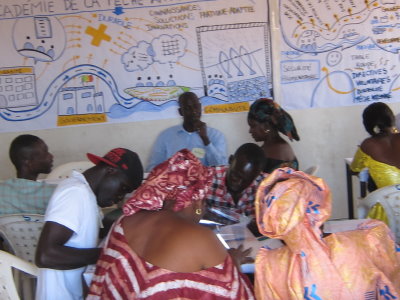 The objective of the training workshop was clarified again as to
The objective of the training workshop was clarified again as to
- Improve the understanding of the local context in Hann as a result of a participatory analysis of the situation of the community by considering the socio-economic and cultural aspects;
- Appreciate the interest of the stakeholders in the academy and more specifically in the initiative "Gender-focused action learning system for sustainable small-scale fishing";
- Learn how to present oneself to others, strike up friendly relationships and listen, analyse and decide together;
- Test the combination of methods and tools for dialogue and graphical facilitation, and the application of simple GALS catalytical diagrammes (vision of a happy life, gender diamond, gender balance tree), as well as sharing structures and mechanisms;
- Discover individual routines, groupings and organisations for the implementation of upcoming activities appropriately.
What represents a Happy Life?
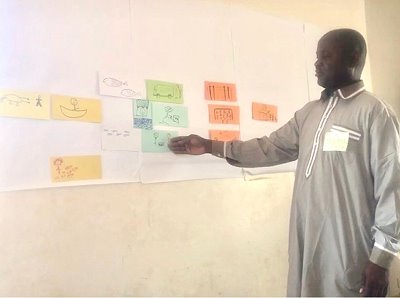
The facilitator then invited participants to draw their vision of a happy life. The majority of drawings representing a happy life consisted of items such as family, home, work tools (pirogue, engine, table for the sale of fish, car, motorcycle, refrigerator for the preservation of fish etc.), access to health and education services, small animals, vegetables and food in abundance.
As part of their homework, participants were invited to enrich their vision further, share their drawing in the family and get at least one member to do their own drawing to enable developing a vision of a happy life for the entire family.
The next step was to introduce the concept of a Value Chain.
A value chain is often understood as an economic system around a particular commercial product, and definitions focus on adding value throughout a series of activities that connect input provision, production, processing, other value addition and marketing until consumption.
It is unlikely that the analysis of a value chain will immediately capture all the different issues at all levels of the chain and for all stakeholders. The objective of developing the SSF value chain in each fishing community must be clear, mutually agreed and transparent from the beginning.
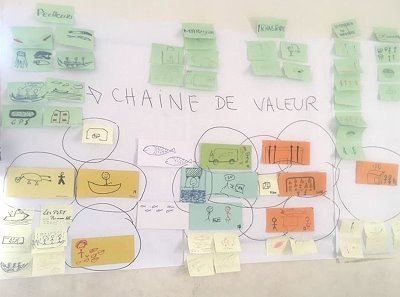 Any initial mapping and stakeholder analysis will need to be reviewed critically. It is only after such a validation process that it can form a reliable basis for future action. It is therefore essential to leave enough time for the scoping process. If done right, in many cases preliminary mapping can provide enough information so that stakeholders themselves can begin to implement actions before the end of the deeper analysis. Identifying concrete and constructive solutions arising from an initial analysis will also increase interest and investment in the academy over the long term.
Any initial mapping and stakeholder analysis will need to be reviewed critically. It is only after such a validation process that it can form a reliable basis for future action. It is therefore essential to leave enough time for the scoping process. If done right, in many cases preliminary mapping can provide enough information so that stakeholders themselves can begin to implement actions before the end of the deeper analysis. Identifying concrete and constructive solutions arising from an initial analysis will also increase interest and investment in the academy over the long term.
After an initial identification of the major segments of the value chain in Hann, participants formed five groups to review their composition, identify the key actors and the advantages and difficulties encountered in each segment.
The groups then discussed their results in the plenary and enriched the initial representation. The result of these intense conversations is seen in the second photo of the more elaborated value chain.
Participants could thus together visualise the interconnections and their individual roles in the sector. Comprehension of the tool and the results of their work was high and homogenous among all participants.
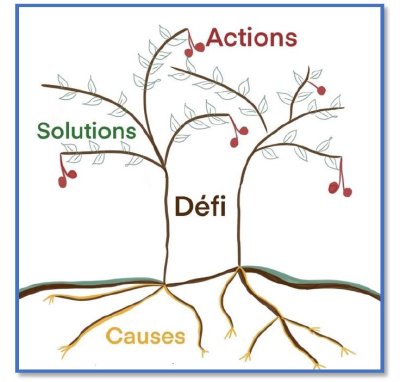 Future work with more and more diverse participants will allow to develop the completeness of the value chain analysis further.
Future work with more and more diverse participants will allow to develop the completeness of the value chain analysis further.
The Diamond of economic activities
The facilitator then introduced the diamond of economic activities that allows to go deeper into the strengths and weaknesses of each profession and economic activity along the value chain.
Each participant developed such a diamond of pros and cons of their activities in their workbooks. They then explained these to the others searching for opportunities to change the negative aspects and increase the positive ones.
The next analytical tool introduced was the Action Tree or Challenge Tree.
Our work is like a tree: it must be well balanced to be able to carry rich fruits. If the roots are not strong, the tree will topple during the first storm. If the fruits on one side are heavier than the other, then the tree will also fall and there will be no harvest the following year.
It is important that the forces acting on the trunk are positive in favour of its upright development and to help the sap to rise from the roots to the branches. If, on the contrary, the tree is blown over by challenges, it may be uprooted.
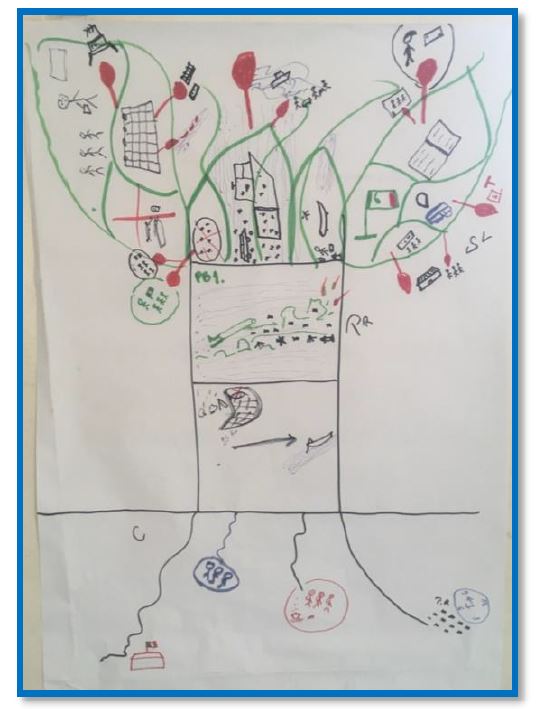
Participants then formed groups according to their profession in order to draw up their specific action tree. These were extensively debated in the plenary.
The tree can also be used to analyse the relative contributions of men and women e.g. in the family business or household. Such a Gender Balance Tree is an awareness tool by visualising who contributes what.
The leadership or Social Empowerment Map
The facilitator then introduced participants to yet another tool, the leadership or social empowerment map. It is the link between the process of individual and collective change.
The first goal is for the trained champions to share the visualisation and analysis with others. The second goal is that those with whom they share the tool will be inspired in turn to share with others so that the messages and the methodology are spread exponentially to form a movement.
The social empowerment map is a very detailed analysis of very sensitive personal issues. At a later stage, once trust and appropriate support services are in place, individual maps can be used as a basis for a detailed analysis of affective, economic and power relations within families and communities, including the analysis of patterns of violence.
The mapping should allow participants to
- Analyse personal and institutional relationships that present opportunities for change, including relationships between spouses, within shared families, relationships within families of blood lines, and the power relations between men within families;
- Identify issues that need to be addressed in personal and institutional relationships;
- Foster a culture and strategies of leadership and peer sharing;
- Develop more advanced analysis and diagramming skills.
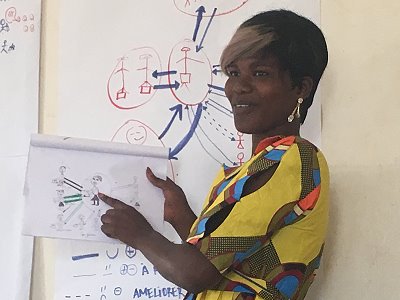 The identification of different facets can help promote and build leadership through support of the SSF academy in order to increase the capacity of different groups along the value chain to better identify and pursue their individual and collective interests and thus move towards implementation of the SSF Guidelines.
The identification of different facets can help promote and build leadership through support of the SSF academy in order to increase the capacity of different groups along the value chain to better identify and pursue their individual and collective interests and thus move towards implementation of the SSF Guidelines.
The facilitator invited participants to draw up a leadership map around themselves to explore how they could support positive developments in their groups and the wider community.
At this stage, it was important to keep it simple and allow participants to appropriate the tool and experience its potential and discuss together how this could be used productively in the future.
Introduction of the medium-term life planner
The last tool introduced during this initial test phase was the medium-term life planner. It consists of identifying an objective out of the happy life scenario that can be achieved within one year.
 The idea is to draw up the objective and the different concrete steps needed within 3-month steps to achieve it. The planning should spell out any risks or potential or real obstacles and the actions needed to overcome or avoid them.
The idea is to draw up the objective and the different concrete steps needed within 3-month steps to achieve it. The planning should spell out any risks or potential or real obstacles and the actions needed to overcome or avoid them.
They were invited to identify at least 10 obstacles and 10 opportunities. The participants drew up their individual plans in their workbooks so that they can monitor progress in the future or learn to make adjustments should some obstacles turn out to be too strong or should more favourable conditions arise on their journey. Most concentrated on improving their income earning capabilities.
They also identified support they could get from family or friends in working towards their objective. The individual understanding of such a planning process was quite heterogeneous among participants.
The sharing in the plenary opened opportunities for co-facilitation and exercising further what had been learnt so far.
Looking back at this exercise, chosing a concrete objective and devising practical measures to be taken in three-month steps to achieve it turned out to be a major challenge for most participants. That should trigger additional support in the follow-up training by the academy.
The more detailed report is available here (FR).









